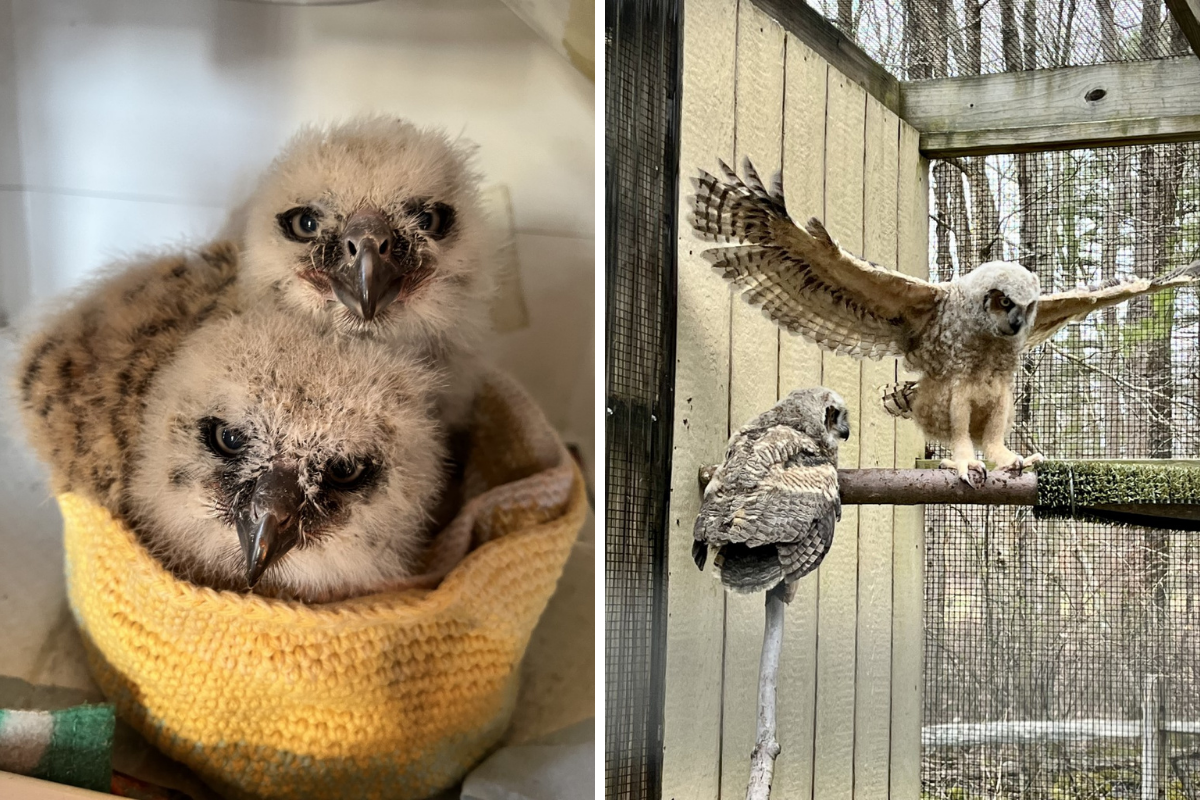Owlets who lost family to rodenticides survive
On social media we have been following the story of two orphaned great horned owlets rescued by a Place Called Hope Rehabilitation Center in Killingworth, Connecticut. The owls lost their family to anticoagulant rodenticide poisoning. We are uplifted by the news they are officially outside—they’ve been moved to an outdoor habitat with Chestnut, the elderly adult great horned owl who is a comfort to any youngster who is at the wildlife rehab center for any duration. The orphans will eventually be released back into the wild.
A Place Called Hope rescued the orphans March 12 and started them on vitamin K1 treatment in case they had potential secondary poisoning. Friends of Animals, A Place Called Hope and Wildlife in Crisis in Weston, Connecticut are pushing for a bill that would create a statewide ban on second-generation anticoagulant rodenticide poisons, which have been harming and killing wildlife all the way up the food chain for a long time. Until that happens people need to stop opting for pest control companies who peddle poison to manage rodents instead of sanitation and exclusion. You can donate to A Place Called Hope’s work here.
Six pups born to a pair of wild red wolves
A species on the brink of extinction—the red wolf—is giving us hope. Last week a litter of endangered red wolves was born to a wild pair of parents in eastern North Carolina for the first time in four years. The six pups were born in the Alligator River National Wildlife Refuge. The U.S. Fish and Wildlife Service’s Red Wolf Recovery Program staff said the litter includes four females and two males.
Red wolves are the rarest canine predator on earth. Only about 15-17 are known to remain in the wild in North Carolina, according to FWS. Before settlers arrived in North America, red wolves thrived throughout the Southeast U.S, from Florida to the Great Plains and the Ohio River Valley. But through hunting, extermination and the expansion of cities and towns, humans drove the species to near extinction.
By 1972, the species was reduced to a small coastal area in southeast Texas and southwest Louisiana. From 1973-1980, the FWS began trapping wild canids in the area to prevent extinction of the species and establish a captive breeding program with the intention of reintroducing the species in the wild. The red wolf was declared extinct in the wild in 1980.
Between 1987 and 1994, more than 60 adult red wolves from the captive population were released into the wild. By the mid-1990s, red wolves in the wild maintained territories, formed packs and successfully bred. By 2011, this reintroduction effort culminated in a known population of 89 red wolves and in 2012 an estimated population as high as 120 red wolves. This was the first time a large carnivore had been declared extinct in the wild and then reintroduced in the United States. It set the stage for several subsequent reintroduction efforts that were modeled after the Red Wolf Recovery Program, such as gray wolves in Yellowstone and central Idaho, Mexican wolves in the southwestern U.S., California condors, and black-footed ferrets.
New Mexico bans trapping on public lands
A ban on the use of traps and snares on New Mexico’s public lands went into effect this month and that’ is something to celebrate. The state has turned the page on the brutal, irresponsible legacy of using traps, snares and poisons on public land for commercial gain or ecological destruction.
The Wildlife Conservation and Public Safety Act was enacted by the state legislature by a single vote in 2021. It makes unlawful the use of “a trap, snare or wildlife poison for the purposes of capturing, injuring or killing an animal on public land.” The legislation has become known as Roxy’s Law, named after an 8-year-old dog who was caught and killed by a neck snare at Santa Cruz Lake in 2018.
With the new law, New Mexico becomes the latest of several western states to enact bans or restrictions on trapping. Colorado prohibits trapping, snares and poison on public and private land, and Arizona bans the use of foothold traps and snares on public lands with some exceptions. California and Washington also impose stringent limitations on trapping.
We are encouraged by efforts by western lawmakers who value native wildlife for their ecological and intrinsic value rather than a paltry price for pelts or predator “control.” We commend them for ushering in an era that regards public lands as a place for recreation and solace, not exploitation and senseless killing.

